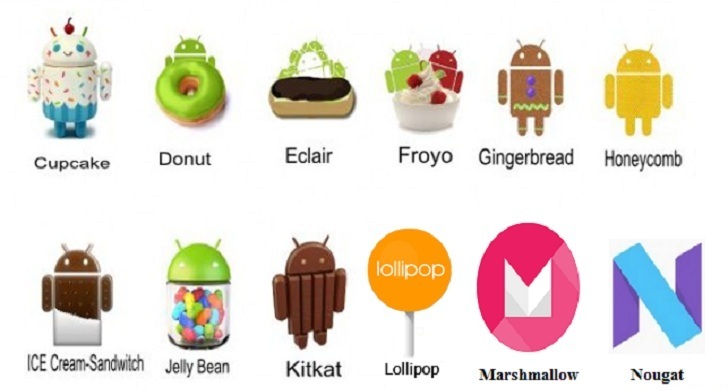Android Version History :
We are aware of the fact that today’s cell phones are known as smart phones. But maybe we don’t know what made it smart? Confused?? You will never be, after going through the text below.
The smartness of our cell phone comes from the smart operating system. Yes, the Android operating system. Let’s make it clear what an operating system is? An operating system is a software program that acts as a medium and allows user to easily communicate with the hardware machine. Let us discuss about android and its versions in detail.
Android the world’s most popular operating system, available with over two million apps to choose from. From cell phones to tablets, wearable, auto console, television etc. android has rooted itself everywhere to give a wonderful user experience, and to make your digital life easy and smart.
The Android operating system is based on Linux kernel and designed mainly to support touch screen mobile devices. It was initially developed by Android Inc., which Google bought in 2k05.Google publicly release ‘Android beta’ in 2k07 and the first commercial version was released in September 2k08. Since then Google and OHA (Open Handset Alliance) are continually updating its features and made it to the release of ‘Oreo’ (Android 8.0) in August 2k17.
The most interesting fact is that all the version except the first two (i.e. except 1.0 & 1.1) are codenamed after the sweets and also follow alphabetical order.
The versions available till date are- 1.0 (no codenamed), 1.1(internally named as Petit Four), Cupcake, Donut, Éclair, Froyo, Gingerbread, Honeycomb, Ice Cream Sandwich, Jelly Bean, KitKat, Lollipop, Marshmallow, Nougat and Oreo. Let us collect some important features and updates in these releases.

Android Version 1.0
Released in September 2k08 and the first commercially available device featuring this version was HTC Dream. It has following features:
- Android Market (Today’s Play Store) to download apps.
- Web Browser, Camera (without any option to change resolution, quality, white balance etc.)
- Folder can be created on Home screen that contains apps icons.
- E-mail access.
- Google Contacts, Google Calendar, Google maps, Google search, Google sync, Google Talk.
- Instant messaging, Text messaging and MMS.
- Notification appears in status bar with option to set ringtone, LED or vibration alert.
- Media player.
- Voice Dialer, Wallpaper change facility.
- YouTube video player.
- Other utilities includes Alarm clock, Calculator and also has Wi-Fi and Bluetooth support.
Android Version 1.1
Released in February 2k09 with little enhancements which includes:
- Attachments can be saved in messages.
- Longer in-call screen timeout when using speakers.
- Ability to show/hide dial pad while calling.
Android Version 1.5 (codename- Cupcake)
Released in April 2k09 and was widely utilized by a number of manufacturers. Improvements made were:
- Camcorder support to record and watch videos in MPEG-4 and 3GP formats.
- Supports uploading of images and videos to Picasa and YouTube.
- Number of Bluetooth improvements includes auto-pairing and stereo support.
- Folders and widgets can be placed on Home screen.
- Animation on various screen transitions.
- On screen keyboard (third party keyboard) with text predictions.
- Auto-rotation option.
- More specific call log.
Android Version 1.6 (codename- Donut)
Released in September 2k09, Enhancements includes:
- New interfaces for camera, camcorder and photo gallery.
- Improved voice search.
- Higher resolution screen support.
- Google turn-by-turn navigation.
- Text to speech engine.
- Multi-touch gesture support.
- VPN (Virtual Private Network) support.
Android Version 2.0 (codename- Éclair)
Released in October 2k09, v2.0 was later updated to v2.1 in January 2k10. Version 2.1 becomes quite popular compared to v2.0. Enhancements made were:
- Improved UI (User Interface).
- Contact and account improvements and synchronization.
- E-mail support for exchange, support for multiple accounts.
- Camera improvements include flash, zoom, white balance, scene modes and macro focus.
- Improved virtual keyboard.
- Browser improvements and support for HTML5.
- Enhanced speed.
- Improvements in Calendar and Google maps.
- Live wallpapers.
- 1 support.
Android Version 2.2 (codename- Froyo)
Released in May 2k10.Enhancements include:
- Tethering with up to eight Wi-Fi hotspots or via USB connection.
- Multi-language keyboard with easy language switching.
- Camera control improvements and more on-screen buttons.
- More performance improvements for faster app access and browser speedups.
- Bluetooth improvements including voice dialing, contact sharing, also provide support for car Bluetooth.
- New home screen tips widgets.
- Improved security(numeric and alpha-numeric passwords)
- Option to disable data access over mobile network.
- Support for installing apps in expandable memory.
- Adobe Flash support.
Android Version 2.3 (codename- Gingerbread)
This version was released in December 2k10, with a number of minor updates and bug fixes. Enhancements include:
- UI becomes simple.
- Faster inputs through virtual keyboard.
- One-touch word selection and copy/paste.
- Improved power management and power usage status.
- Application status and the ability to manually stop app.
- Internet phone calling.
- Near-Field communication (NFC) support to read NFC tags.
- New download manager.
- Multiple camera support (i.e. front and rear)
- Support for barometer, gyroscope, linear acceleration, and rotation vector sensors.
Android Version 3.0 (codename- Honeycomb)
Released in February 2k11, and mainly for devices with large screens such as tablets. The first device featuring this version was Motorola Xoom tablet. Enhancements include:
- New UI optimized for tablets includes new system bar, action bar, customized home screen and recent apps list.
- Redesigned keyboard for faster and more accurate entry.
- Improved text selection, copy and paste.
- Synchronize media files via USB.
- Support for physical keyboard via BT or USB.
- Bluetooth Tethering.
- Updated apps for larger screens including browser, camera, gallery, contacts, and email.
- Support for Multi-core processors.
- High-performance 2D and 3D graphic support.
Version 3.1 (also codenamed as Honeycomb)
Released in May 2k11 and this release also focused on devices having larger screens. Enhancements include:
- UI refinements to navigation and animation.
- Expanded recent app list.
- Resizable home screen widgets.
- USB devices and accessories supported, including mouse, keyboard, digital camera, also provide support for joystick and gamepads.
- Improved Wi-Fi networking stability, including connection while the screen is off.
- Updated standard apps such as browser, calendar, contacts and email.
- Enterprise support feature.
Version 3.2 (also codenamed as Honeycomb)
Released in July 2k11, Enhancement over prior versions includes:
- Further enhancement for tablets.
- Compatibility zooms for fixed-size apps.
- Direct app access to SD card file system.
- Extended screen API for managing different screen sizes.
Android Version 4.0 (codename- Ice Cream Sandwich)
This version was released in October 2k11. It merges the 3.x tab centric design and the v2.x phone based design into a single version. Enhancements include:
- Refined UI.
- Recent app selection.
- Home folders and favorites tray.
- Lock screen actions.
- Quick response for calls.
- Network data control.
Other areas of improvement include:
- Social networking improvement.
- Unified calendar.
- Camera and camcorder updates include face detection, image stabilization, snapshots while recording, and new gallery app with photo editor.
- Brower supported desktop versions of sites.
- Improved email.
- Face Unlock.
- Wi-Fi direct support.
Other minor versions were 4.0.1, 4.0.2, 4.0.3, 4.0.4, released with enhanced security and bug fixes.
Android Version 4.1 (codename- Jelly Bean)
This version was released in July 2k12. Enhancements include:
- Improved touch response and transition.
- Expandable, actionable notifications.
Other improvements include:
- Instant view of clicked photos.
- External Braille input and output via USB.
- Improved voice search.
- NFC based photo sharing.
- USB audio.
- Google wallet.
Other minor versions released were 4.1.1 and 4.1.2.
Version 4.2 (also codenamed as Jelly Bean)
Released in October 2k12 and retains the prior’s release codename. Enhancements include:
- Multiple users for tablets.
- Photo sphere to take 360 degree images.
- Built-in keyboard gesture typing.
Other versions include 4.2.1 and 4.2.2 released in November 2k12 and February 2k13 respectively.
Version 4.3 (also codenamed as Jelly Bean)
Announced in July 2k13 and with the prior’s release codename. Enhancements include:
- Restricted profiles for tablets.
- Improved Bluetooth power efficiency.
- Dial-pad auto complete.
- Improved Right-to-left language support.
- Faster user switching from lock screen.
- 4K Resolution support.
Other versions include 4.3.1 released in October 2k13 with bug fixes.
Android Version 4.4 (codename- KitKat)
This version was released in October 2k13. Enhancements include:
- ‘Ok Google’ Support to start voice operation.
- Lock screen displaying current running app notification and required controls.
- Immersive mode hides everything except the active content.
- Faster multi-tasking.
- Priority contacts listing.
- Hangouts, for all messages in one place.
Another minor updates were 4.4.1, 4.4.2, 4.4.3, 4.4.4.
Also the v4.4W was released in June 2k14 exclusively for wearable devices and the minor updates include 4.4W.1 and 4.4W.2.
Android Version 5.0 (codename- Lollipop)
Released in November 2k14 and the areas that are new and improved were:
- Responsive UI with natural lighting and shadows.
- Improved notification, selective notification and prioritization of notifications.
- Battery saver, estimated time for complete charging.
- New smart-lock features.
- Sharing for guests and access to contacts from other phones.
- Improved Bluetooth operations.
- Support for 64-bit CPUs.
- Android TV.
Another minor versions include 5.0.1 and 5.0.2 released in December 2k14) with bug fixes.
Version 5.1 (also codenamed as Lollipop)
Announced in March 2k15, areas that are new and improved was:
- Support for multiple SIM cards.
- High definition phone calls support.
- Enhancement to join Wi-Fi network.
- Device protection for lost or stolen devices.
- Control of paired Bluetooth device.
Another minor version 5.1.1 was released in April 2k15 with minor bug fixes and native calling support.
Android Version 6.0 (codename- Marshmallow)
Released in October 2K15 and the new and improved areas are:
- Improved privacy controls.
- Fingerprint sensor support.
- Easier transition from older devices.
- Reduced battery consumption while in sleep.
- Introduction to Doze mode, which reduce CPU speed while the screen is off to save battery.
- App standby feature.
- Renamed ‘Priority mode’ to “Do Not Disturb’ mode.
- USB type-C support.
- MIDI support for musical instruments.
- Experimental multi-window feature.
Version 6.0.1 was also released in December 2k15 with minor improvements. These include:
- Description for USB connection options.
- Double-tap power button to open camera.
- Unicode 7.0 and 8.0 emoji support.
Android Version 7.0 (codename- Nougat)
Released publicly in August 2k16, major improvements include:
- Multiple device locales
- Vulkan-3D rendering API.
- Unicode 9.0 emoji support.
- Ability to display color calibration.
- Ability to screen zoom.
- Ability to switch apps by double tapping in overview button.
- Added ‘Clear All’ button in overview screen.
- VR interface.
- Improved Doze functionality to improve battery life.
- Multi-window support, which supports floating apps on a desktop layout.
- New Data saver mode.
- New JIT compiler for faster app installations.
Version 7.1 (also codenamed as Nougat)
Released in October 2k16 with the enhancements given below:
- Swipe gesture in fingerprint sensor.
- Rearranged notification shade.
- Circular app icon support.
- Multi-endpoint call support.
Version 7.1.1 was also released in December 2k16 which include:
- New set of emoji.
- Send GIFs directly from default keyboard.
- App shortcut: Launch actions on app by long pressing the app icon.
- CPU usage feature removed.
Version 7.1.2 was released later in April 2k17 which includes:
- Battery usage alert.
- Improved fingerprint swipe.
- Bluetooth connectivity improvements.
Android Version 8.0 (codename- Oreo)
Released in August 2k17, major improvements include:
- Project Treble (a modular architecture that makes it easier for hardware makers to deliver android updates).
- Support for Unicode 10.0 emoji.
- Redesigned quick settings and settings.
- Restructured settings by regrouping in sections similar entities.
- Adaptive icons.
- Notification dots (badges).
- System-wide auto-fill framework.
- Multi-display support.
- Wi-Fi assistant.
- Google Play-Protect.
- 2 times faster boot time.
- Deep color.
- Apps background execution and location limits.
Also Read :

























I view something truly special in this internet site.